Simon Woodhead
PIIvot: A Lightweight NLP Anonymization Framework for Question-Anchored Tutoring Dialogues
May 22, 2025Abstract:Personally identifiable information (PII) anonymization is a high-stakes task that poses a barrier to many open-science data sharing initiatives. While PII identification has made large strides in recent years, in practice, error thresholds and the recall/precision trade-off still limit the uptake of these anonymization pipelines. We present PIIvot, a lighter-weight framework for PII anonymization that leverages knowledge of the data context to simplify the PII detection problem. To demonstrate its effectiveness, we also contribute QATD-2k, the largest open-source real-world tutoring dataset of its kind, to support the demand for quality educational dialogue data.
LookAlike: Consistent Distractor Generation in Math MCQs
May 03, 2025Abstract:Large language models (LLMs) are increasingly used to generate distractors for multiple-choice questions (MCQs), especially in domains like math education. However, existing approaches are limited in ensuring that the generated distractors are consistent with common student errors. We propose LookAlike, a method that improves error-distractor consistency via preference optimization. Our two main innovations are: (a) mining synthetic preference pairs from model inconsistencies, and (b) alternating supervised fine-tuning (SFT) with Direct Preference Optimization (DPO) to stabilize training. Unlike prior work that relies on heuristics or manually annotated preference data, LookAlike uses its own generation inconsistencies as dispreferred samples, thus enabling scalable and stable training. Evaluated on a real-world dataset of 1,400+ math MCQs, LookAlike achieves 51.6% accuracy in distractor generation and 57.2% in error generation under LLM-as-a-judge evaluation, outperforming an existing state-of-the-art method (45.6% / 47.7%). These improvements highlight the effectiveness of preference-based regularization and inconsistency mining for generating consistent math MCQ distractors at scale.
DiVERT: Distractor Generation with Variational Errors Represented as Text for Math Multiple-choice Questions
Jun 27, 2024



Abstract:High-quality distractors are crucial to both the assessment and pedagogical value of multiple-choice questions (MCQs), where manually crafting ones that anticipate knowledge deficiencies or misconceptions among real students is difficult. Meanwhile, automated distractor generation, even with the help of large language models (LLMs), remains challenging for subjects like math. It is crucial to not only identify plausible distractors but also understand the error behind them. In this paper, we introduce DiVERT (Distractor Generation with Variational Errors Represented as Text), a novel variational approach that learns an interpretable representation of errors behind distractors in math MCQs. Through experiments on a real-world math MCQ dataset with 1,434 questions used by hundreds of thousands of students, we show that DiVERT, despite using a base open-source LLM with 7B parameters, outperforms state-of-the-art approaches using GPT-4o on downstream distractor generation. We also conduct a human evaluation with math educators and find that DiVERT leads to error labels that are of comparable quality to human-authored ones.
Math Multiple Choice Question Generation via Human-Large Language Model Collaboration
May 01, 2024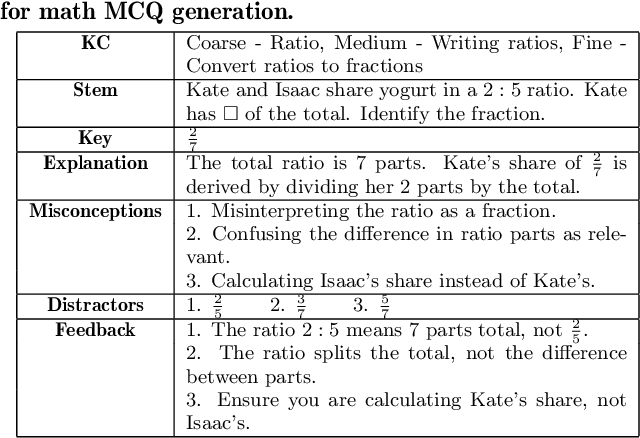
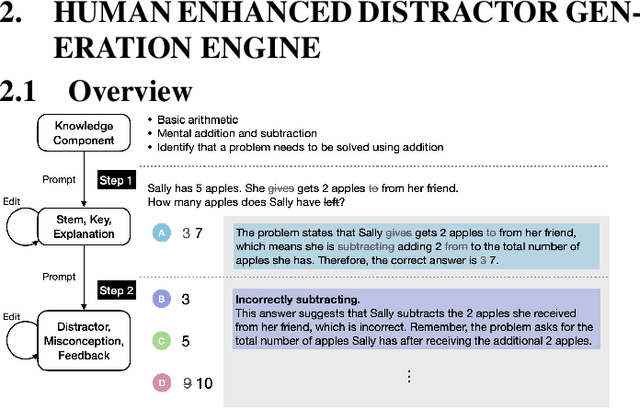
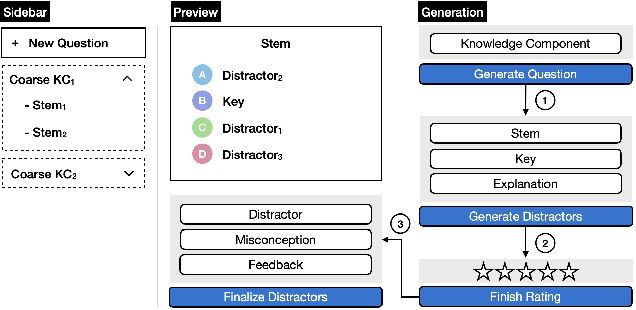

Abstract:Multiple choice questions (MCQs) are a popular method for evaluating students' knowledge due to their efficiency in administration and grading. Crafting high-quality math MCQs is a labor-intensive process that requires educators to formulate precise stems and plausible distractors. Recent advances in large language models (LLMs) have sparked interest in automating MCQ creation, but challenges persist in ensuring mathematical accuracy and addressing student errors. This paper introduces a prototype tool designed to facilitate collaboration between LLMs and educators for streamlining the math MCQ generation process. We conduct a pilot study involving math educators to investigate how the tool can help them simplify the process of crafting high-quality math MCQs. We found that while LLMs can generate well-formulated question stems, their ability to generate distractors that capture common student errors and misconceptions is limited. Nevertheless, a human-AI collaboration has the potential to enhance the efficiency and effectiveness of MCQ generation.
Exploring Automated Distractor Generation for Math Multiple-choice Questions via Large Language Models
Apr 05, 2024



Abstract:Multiple-choice questions (MCQs) are ubiquitous in almost all levels of education since they are easy to administer, grade, and are a reliable format in assessments and practices. One of the most important aspects of MCQs is the distractors, i.e., incorrect options that are designed to target common errors or misconceptions among real students. To date, the task of crafting high-quality distractors largely remains a labor and time-intensive process for teachers and learning content designers, which has limited scalability. In this work, we study the task of automated distractor generation in the domain of math MCQs and explore a wide variety of large language model (LLM)-based approaches, from in-context learning to fine-tuning. We conduct extensive experiments using a real-world math MCQ dataset and find that although LLMs can generate some mathematically valid distractors, they are less adept at anticipating common errors or misconceptions among real students.
Improving the Validity of Automatically Generated Feedback via Reinforcement Learning
Mar 02, 2024Abstract:Automatically generating feedback via large language models (LLMs) in intelligent tutoring systems and online learning platforms has the potential to improve the learning outcomes of many students. However, both feedback generation and evaluation are challenging: feedback content has to be valid especially in subjects like math, which requires models to understand the problem, the solution, and where the student's error lies. Feedback also has to be pedagogically valid to reflect effective tutoring strategies, such as explaining possible misconceptions and encouraging the student, among other desirable features. In this work, we address both problems of automatically generating and evaluating feedback while considering both correctness and alignment. First, we propose a rubric for evaluating math feedback and show that GPT-4 is able to effectively use it to annotate human-written and LLM-generated feedback. Second, we propose a framework for feedback generation that optimizes both correctness and alignment using reinforcement learning (RL). Specifically, we use GPT-4's annotations to create preferences over feedback pairs in an augmented dataset for training via direct preference optimization (DPO). We show that our methods significantly increase the correctness and alignment of generated feedback with Llama 2, an open-source LLM, qualitatively analyze our generation and evaluation systems using case studies, and outline several areas for future work.
Novice Learner and Expert Tutor: Evaluating Math Reasoning Abilities of Large Language Models with Misconceptions
Oct 03, 2023
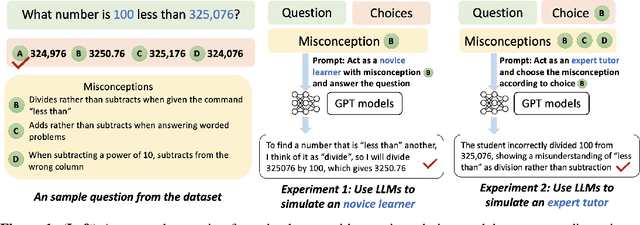
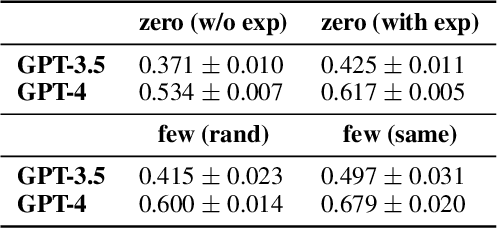
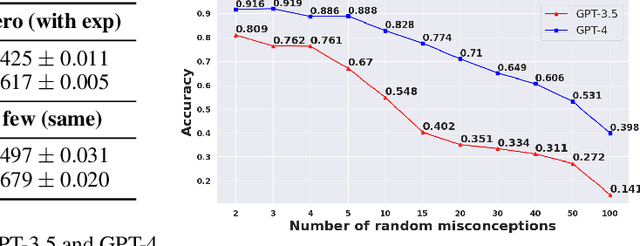
Abstract:We propose novel evaluations for mathematical reasoning capabilities of Large Language Models (LLMs) based on mathematical misconceptions. Our primary approach is to simulate LLMs as a novice learner and an expert tutor, aiming to identify the incorrect answer to math question resulted from a specific misconception and to recognize the misconception(s) behind an incorrect answer, respectively. Contrary to traditional LLMs-based mathematical evaluations that focus on answering math questions correctly, our approach takes inspirations from principles in educational learning sciences. We explicitly ask LLMs to mimic a novice learner by answering questions in a specific incorrect manner based on incomplete knowledge; and to mimic an expert tutor by identifying misconception(s) corresponding to an incorrect answer to a question. Using simple grade-school math problems, our experiments reveal that, while LLMs can easily answer these questions correctly, they struggle to identify 1) the incorrect answer corresponding to specific incomplete knowledge (misconceptions); 2) the misconceptions that explain particular incorrect answers. Our study indicates new opportunities for enhancing LLMs' math reasoning capabilities, especially on developing robust student simulation and expert tutoring models in the educational applications such as intelligent tutoring systems.
Exploring Automated Distractor and Feedback Generation for Math Multiple-choice Questions via In-context Learning
Aug 07, 2023



Abstract:Multiple-choice questions (MCQs) are ubiquitous in almost all levels of education since they are easy to administer, grade, and are a reliable format in both assessments and practices. An important aspect of MCQs is the distractors, i.e., incorrect options that are designed to target specific misconceptions or insufficient knowledge among students. To date, the task of crafting high-quality distractors has largely remained a labor-intensive process for teachers and learning content designers, which has limited scalability. In this work, we explore the task of automated distractor and corresponding feedback message generation in math MCQs using large language models. We establish a formulation of these two tasks and propose a simple, in-context learning-based solution. Moreover, we explore using two non-standard metrics to evaluate the quality of the generated distractors and feedback messages. We conduct extensive experiments on these tasks using a real-world MCQ dataset that contains student response information. Our findings suggest that there is a lot of room for improvement in automated distractor and feedback generation. We also outline several directions for future work
NeurIPS Competition Instructions and Guide: Causal Insights for Learning Paths in Education
Aug 31, 2022
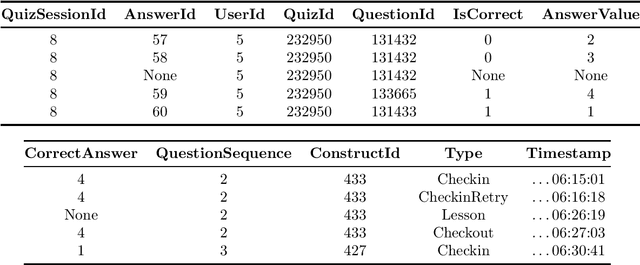

Abstract:In this competition, participants will address two fundamental causal challenges in machine learning in the context of education using time-series data. The first is to identify the causal relationships between different constructs, where a construct is defined as the smallest element of learning. The second challenge is to predict the impact of learning one construct on the ability to answer questions on other constructs. Addressing these challenges will enable optimisation of students' knowledge acquisition, which can be deployed in a real edtech solution impacting millions of students. Participants will run these tasks in an idealised environment with synthetic data and a real-world scenario with evaluation data collected from a series of A/B tests.
VICause: Simultaneous Missing Value Imputation and Causal Discovery with Groups
Oct 15, 2021

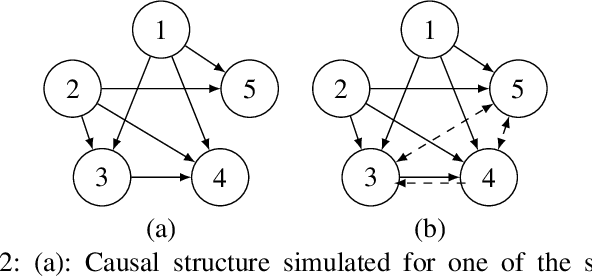
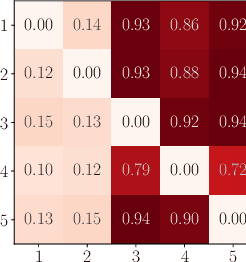
Abstract:Missing values constitute an important challenge in real-world machine learning for both prediction and causal discovery tasks. However, existing imputation methods are agnostic to causality, while only few methods in traditional causal discovery can handle missing data in an efficient way. In this work we propose VICause, a novel approach to simultaneously tackle missing value imputation and causal discovery efficiently with deep learning. Particularly, we propose a generative model with a structured latent space and a graph neural network-based architecture, scaling to large number of variables. Moreover, our method can discover relationships between groups of variables which is useful in many real-world applications. VICause shows improved performance compared to popular and recent approaches in both missing value imputation and causal discovery.
 Add to Chrome
Add to Chrome Add to Firefox
Add to Firefox Add to Edge
Add to Edge